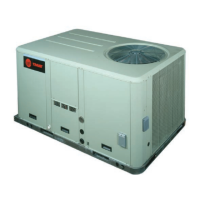Troubleshooting
76 RT-SVX21AC-EN
Test 4 - LED Indicator Test, (SYS ON,
HEAT, COOL and SERVICE)
Method 1
Testing the LED using a meter with diode test function.
Test both forward and reverse bias. Forward bias should
measure a voltage drop of 1.5 to 2.5 volts, depending on
your meter. Reverse bias will show an Over Load, or open
circuit indication if LED is functional.
Method 2
Testing the LED with an analog Ohmmeter. Connect
Ohmmeter across LED in one direction, then reverse the
leads for the opposite direction. The LED should have at
least 100 times more resistance in reverse direction, as
compared with the forward direction. If high resistance in
both directions, LED is open. If low in both directions, LED
is shorted.
Method 3
To test LED’s with ZSM connected to unit, test voltages at
LED terminals on ZSM. A measurement of 32 Vdc, across
an unlit LED, means the LED has failed.
Relative Humidity Sensor Test
This component is measured by measuring the DC mA
output signal on the Relative Humidity Sensor. Verify
accuracy of the sensor annually. If the output reading is
DC mA 0, first verify that power is applied to the sensor. A
reading of
4 corresponds to 0% RH and 20 DC mA
corresponds to 100% RH.
Note: Me
asurements should be made from LED common
(ZSM terminal 6 to respective
LED terminal).
Programmable and Digital Zone Sensor
Test
Testing serial communication voltage
1. Verify 24 Vac is present between terminals J6-14 and
J6-11.
2. Discon
nect wires from J6-11 and J6-12. Measure the
voltage betwee
n J6-11 and J6-12, should be about 32
Vdc.
3. Reconnect wires to terminals J6-11 and J6-12.
Mea
sure vo
ltage again between J6-11 and J6-12,
voltage should flash high and low every 0.5 seconds.
The voltage on the low end will measure about 19 Vdc,
while the voltage on the high end will measure from
approximately 24 to 38 Vdc.
4. Verify all modes of operation, by running the unit
th
rough all of the
steps in the “Test Modes” section
discussed in “Unit Start-Up”.
5. After verifying proper unit operation, exit the test
mode. Turn
the fan on continuously at the ZSM, by
pressing the button with the fan symbol. If the fan
comes on and runs continuously, the ZSM is good. If
you are not able to turn the fan on, the ZSM is
defective.
ReliaTel™ Refrigeration Module (RTRM)
Default Chart
If the RTCI loses input from the building management
system, the RTRM will control in the default mode after
approximately 15 minutes. If the RTRM loses the Heating
and Cooling setpoint input, the RTRM will control in the
default mode instantaneously. The temperature sensing
thermistor in the Zone Sensor Module is the only
component required for the “Default Mode” to operate.
Unit Operation without a Zone Sensor
This procedure is for temporary operation only. The
economizer and condenser fan cycling functions are
disabled.
1. Open and Lock the unit disconnect switch.
2. Remove the Outside Air Sensor (OAS) from
the
condenser section of unit.
3. Use two (2) wire nuts, to in
dividual
ly cap the wires.
4. Locate the RTRM (J6). Connect two (2) wires to
terminals
J6-1 and 2.
5. Connect the sensor (OAS) using two wire nuts to the
two (2)
field supplied wires that were connected to
terminals 1 and 2 on J6.
Unit Economizer Control (ECA)
Troubleshooting
ReliaTel™ Control
Verify Economizer Status by Economizer Actuator (ECA)
LED indicator:
• OFF: No power or failure
• ON: Normal, OK to economize
• Slow Flash: Normal, not OK to economize
% RH DC mA
30 8.8
40 10.4
50 12.0
60 13.6
70 15.2
80 16.8
WARNING
Hazardous Voltage!
Failure to disconnect power before servicing could
result in death or serious injury. Disconnect all electric
power, including remote disconnects before servicing.
Follow proper lockout/tagout procedures to ensure the
power can not be inadvertently energized.

